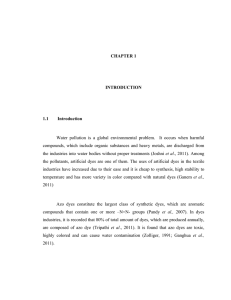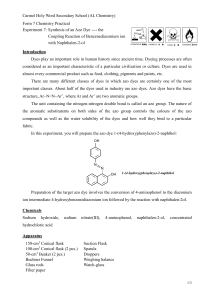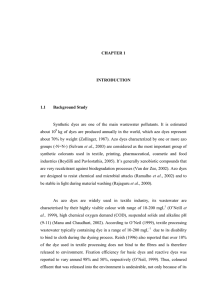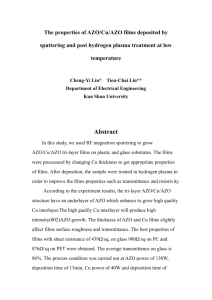CHAPTER 1 INTRODUCTION 1.1
advertisement
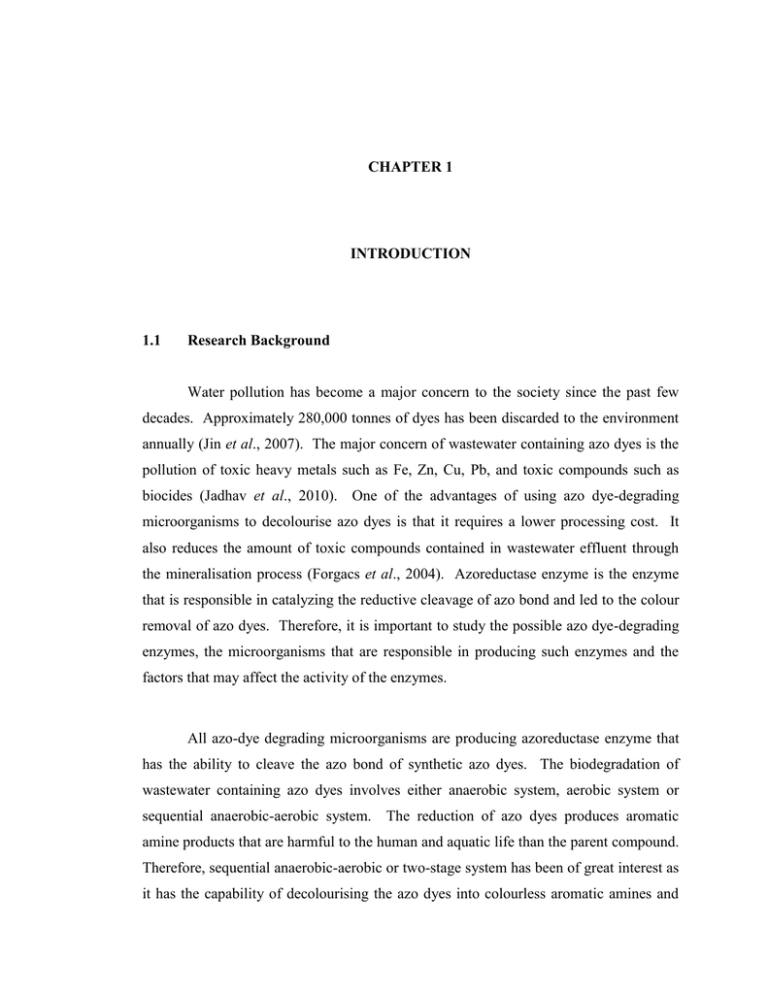
1 CHAPTER 1 INTRODUCTION 1.1 Research Background Water pollution has become a major concern to the society since the past few decades. Approximately 280,000 tonnes of dyes has been discarded to the environment annually (Jin et al., 2007). The major concern of wastewater containing azo dyes is the pollution of toxic heavy metals such as Fe, Zn, Cu, Pb, and toxic compounds such as biocides (Jadhav et al., 2010). One of the advantages of using azo dye-degrading microorganisms to decolourise azo dyes is that it requires a lower processing cost. It also reduces the amount of toxic compounds contained in wastewater effluent through the mineralisation process (Forgacs et al., 2004). Azoreductase enzyme is the enzyme that is responsible in catalyzing the reductive cleavage of azo bond and led to the colour removal of azo dyes. Therefore, it is important to study the possible azo dye-degrading enzymes, the microorganisms that are responsible in producing such enzymes and the factors that may affect the activity of the enzymes. All azo-dye degrading microorganisms are producing azoreductase enzyme that has the ability to cleave the azo bond of synthetic azo dyes. The biodegradation of wastewater containing azo dyes involves either anaerobic system, aerobic system or sequential anaerobic-aerobic system. The reduction of azo dyes produces aromatic amine products that are harmful to the human and aquatic life than the parent compound. Therefore, sequential anaerobic-aerobic or two-stage system has been of great interest as it has the capability of decolourising the azo dyes into colourless aromatic amines and 2 further oxidizes it into less toxic and more stable compounds. Azo dye reduction occurs preferentially under anaerobic condition. Ramalho et al. (2004) has observed a faster decolourisation rate of azo dyes at low oxygen concentration. Azoreductase enzyme has been isolated and identified from various species of microorganisms. environment. These enzymes are either oxygen insensitive or sensitive in the Azoreductase from different sources of microorganisms would have different enzyme properties such as they can be categorised as flavin-dependent, flavinindependent and many others (Ghosh et al., 1992). Therefore, several studies have been done on microorganisms which have the ability to produce azoreductase enzyme to determine their specific characterisitics such as Pseudomonas KF46 (Zimmermann et al., 1982), Enterobacter agglomerans (Moutaouakkil et al., 2003), Staphylococcus aureus (Chen et al., 2005), Micrococcus strain (Olukanni et al., 2009). Fungi also has the ability to produce azoreductase, one such example is using Issatchenkia occidentalis which is used for decolourisation of methyl orange and orange II (Ramalho et al., 2004). In some studies, mixed bacterial culture is more preferable than the pure bacterial culture as it has higher co-metabolic activities within a microbial community. However, the ability of pure bacterial culture in biodegradation of azo dyes producing azoreductase is much easier to be observed and studied in terms of its specific activity. 3 1.2 Problem of Statement Azoreductase is responsible for reducing the azo double bond in azo dyes structures by enzymatic biotransformation step to produce colourless amine products and reduce them to a more stable product (Zimmermann et al., 1982). However, azoreductase isolated from different microorganisms varies in their enzymatic activities (Nakanishi et al., 2001). Therefore, there is a need to study the characteristics of azoreductase-mediated biodegradation in terms of various environmental effects. Therefore, further studies on the characterisation of azoreductase in terms of its activity and stability should be done in order to obtain the maximum production and enzyme activity of azoreductase for the purpose of biological textile wastewater treatment. A higher specific enzyme activity of azoreductase was expected in azo dyes decolourisation with the used of pure bacterial culture. This is because the results may not be affected by other properties of unknown microorganisms or mixed bacterial cultures. 1.3 Research Objectives There are 2 main objectives of this study:- 1. To optimise the decolourisation of Reactive Black 5 using azoreductase produced by Brevibacillus panacihumi under sequential anaerobic-aerobic condition. 2. To optimise the azoreductase assay conditions; pH, temperature, substrate concentration, NADH concentration and Ionic liquids concentration. 4 1.4 Scopes of Research This project is mainly focused on the localisation and characterisation of crude azoreductase produced by azo dye-degrading bacteria using pure culture of Brevibacillus panacihumi. The localisation of azoreductase was first determined in order to obtain the crude enzyme extracts with the highest azoreductase activity. Lowry method was used to determine the protein concentration. The effects of pH, temperature, substrate concentration, NADH concentration and Ionic liquids concentration on crude azoreductase activity and stability were determined using azoreductase assay. 1.5 Research Significance Textile industries have contributed about 73 to 167 m3 of the wastewater per tonne of product and accounted for 22% of the total volume of industrial wastewater produced in Malaysia (Idris et al., 2007). Thus, the biological method has been introduced to overcome the problems of conventional method that produces high sludge contents (Lucas and Peres, 2009). The enzyme involved in the biodegradation of azo dyes is mainly azoreductase. Azoreductase enzyme has been proven to have highly stable physiochemical properties. Therefore, azoreductase has been widely investigated and characterised in order to obtain the highest enzyme activity with a higher capability of azo dyes removal. Some aerobic bacteria have the ability to reduce the azo bond of synthetic azo dye by oxygen-insensitive or using aerobic azoreductase (Mazumdar et al., 1999). In addition, some anaerobic bacteria also have the ability to produce different forms of azoreductase (Horikoshi, 1999). This may contribute to a better biodegradation of azo dyes to be used for biological treatment of industrial wastewater containing azo dyes (Ooi et al., 2007).
